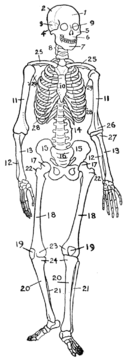Osteology

Osteology is the scientific study of bones, practiced by osteologists. A subdiscipline of anatomy, anthropology, and archeology, osteology is a detailed study of the structure of bones, skeletal elements, teeth, microbone morphology, function, disease, pathology, the process of ossification (from cartilaginous molds), the resistance and hardness of bones (biophysics), etc. often used by scientists with identification of vertebrate remains with regard to age, death, sex, growth, and development and can be used in a biocultural context.
Osteology and osteologists should not be confused with the alternative medical practice known as osteopathy and its practitioners, osteopaths.
Methods
A typical analysis will include:
- an inventory of the skeletal elements present
- a dental inventory
- aging data, based upon epiphyseal fusion and dental eruption (for subadults) and deterioration of the pubic symphysis or sternal end of ribs (for adults)
- stature and other metric data
- ancestry
- non-metric traits
- pathology and/or cultural modifications
Applications


Osteological approaches are frequently applied to investigations in disciplines such as vertebrate paleontology, zoology, forensic science, physical anthropology and archaeology, and has a place in research on topics including:
- Ancient warfare
- Activity patterns
- Criminal investigations
- Demography
- Developmental biology
- Diet
- Disease
- Genetics of early populations
- Fossil assembledges
- Health
- Human migration
- Identification of unknown remains
- Physique
- Social inequality
- War crimes
See also
References
- Bass, W. M. 2005. Human Osteology: A Laboratory and Field Manual. 5th Edition. Columbia: Missouri Archaeological Society.
- Buikstra, J. E. and Ubelaker, D. H. (eds.) 1994. Standards for Data Collection from Human Skeletal Remains. Arkansas Archeological Survey Research Series No. 44.
- Cox, M and Mays, S. (eds.) 2000. Human Osteology in Archaeology and Forensic Science. London: Greenwich Medical Media.
